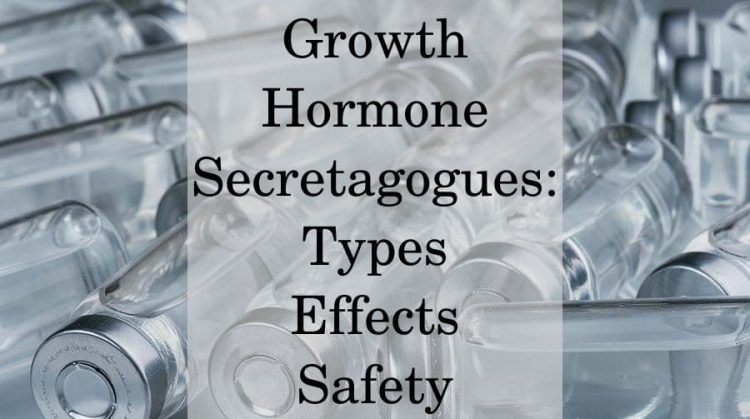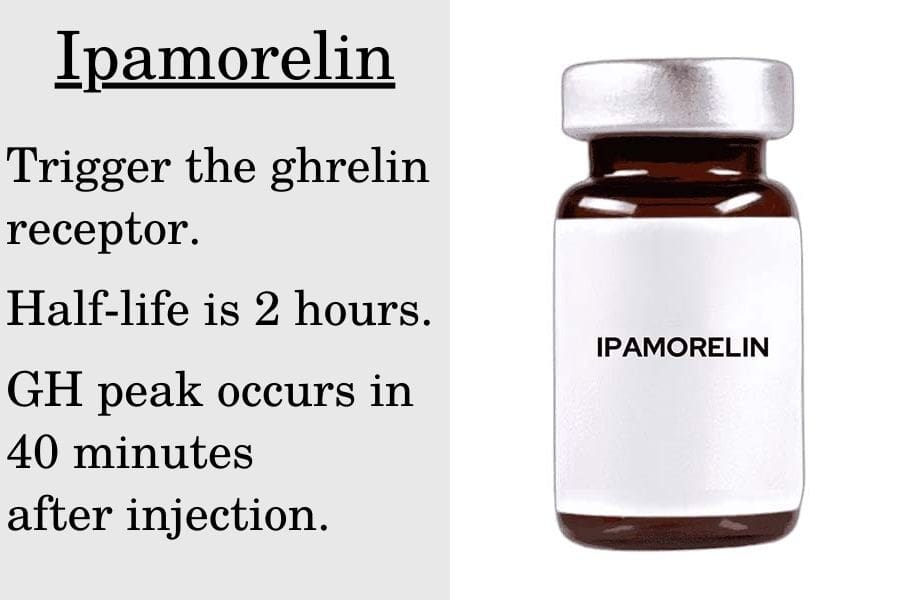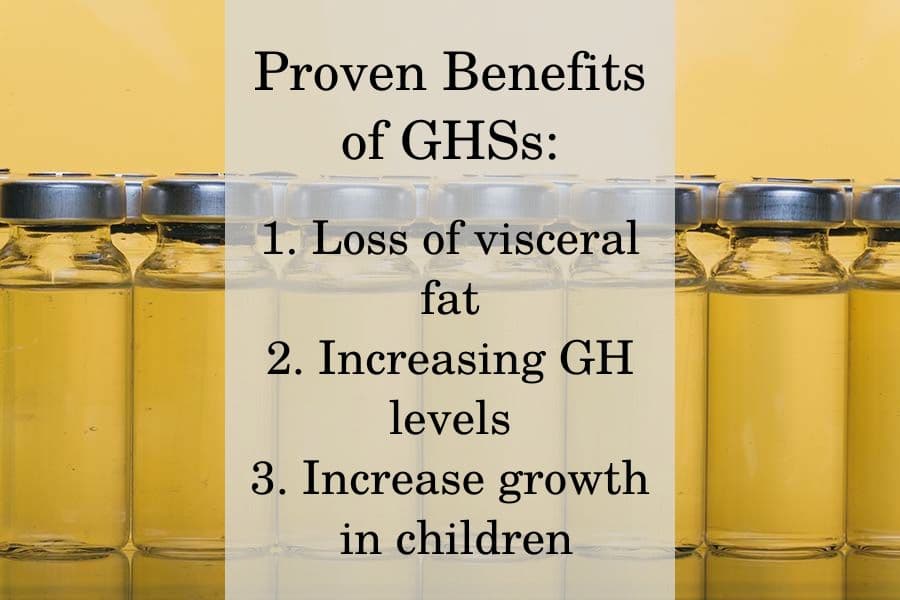
Recombinant human growth hormone (HGH) therapy is currently the most studied and the only legally available therapy for the management of growth hormone deficiency (GHD) in both children and adults.
Nevertheless, scientists have explored alternative therapies like growth hormone secretagogues (GHS) as a potential replacement for HGH in people with GHD and other conditions.
That’s because these therapeutics can stimulate the body’s natural production of HGH, and their effect is a subject of regulatory feedback from the organism.
Thus they may have a lower risk of potential side effects such as insulin resistance, joint pain, and fluid retention since they cannot lead to a supraphysiological increase in GH levels for extended periods of time.
However, their effects are limited by the remaining functional capacity of the pituitary gland, and GHS has no effect in patients with severe pituitary damage.
Most GH secretagogues are poorly researched for safety and effectiveness and thus not approved for human use
Currently, there are just two FDA-approved GHSs, one of which is available only as a generic medication and is used mainly for diagnosing GHD. Thus, they are the only GHS that can be legally prescribed to patients.
What are GHSs?
GHSs are a class of synthetic compounds that stimulate the production and release of growth hormone (GH) from the pituitary gland. They work by interacting with specific receptors in the body that regulate GH secretion.
There are two main types of GHSs: those that trigger the ghrelin receptor and those that mimic the action of growth hormone-releasing hormone (GHRH), a natural hormone that stimulates HGH production and release.
GHSs that mimic GHRH include compounds such as Sermorelin and Tesamorelin.
These compounds are synthetic peptides that act as GHRH analogs, binding to the same receptor as GHRH and stimulating GH release, which can improve body composition, increase muscle mass, and decrease fat mass.
Other GHSs work by triggering the ghrelin receptor, also known as the GHS receptor. The GHS receptor is found in the hypothalamus and pituitary gland and stimulates the release of GH.
Examples include compounds such as Ipamorelin, GHRP-2, and GHRP-6. When activating the ghrelin receptor, they work by increasing the production of HGH but also often exert other endocrine effects related to ghrelin.
Studies also show that regardless of whether the medications activate the GHRH or GHS receptor, they work by increasing the pulsatile release of GH from the pituitary gland.
However, the total increase in HGH levels is limited because their effect is a subject of negative feedback from somatostatin and IGF-1.
Currently, most GHSs are still under investigation and have uncertain safety and effectiveness. Nevertheless, GH secretagogues are often used as a form of doping in sports and athletic performance.
Athletes and bodybuilders often use them in an attempt to stimulate the release of growth hormone from the pituitary gland, which may increase muscle mass, reduce body fat, and improve physical performance.
The use of GH secretagogues as a form of doping is banned by the World Anti-Doping Agency (WADA) and other sports organizations. This includes both synthetic GH secretagogues and natural compounds that can stimulate growth hormone release.
List of GHS
The most well-known and studied growth hormone secretagogues include the ghrelin-mimetics:
- Ipamorelin
- MK-677 (Ibutamoren)
- GHRP-2 (pralmorelin)
- GHRP-6
- Hexarelin
and the GHRH-mimetics
- CJC-1295
- Sermorelin
- Tesamorelin
All of these GH secretagogues are synthetically manufactured. Natural GHSs such as ghrelin and GHRH have limited use due to their short-half life.
Tesamorelin
Tesamorelin is arguably the most well-studied in humans compared to other GHS. This has led to the approval of tesamorelin for therapy in abnormal fat distribution called lipodystrophy which often occurs in HIV-infected individuals.
It’s currently available as a prescription medication for the management of lipodystrophy.
Tesamorelin has a similar structure to GHRH, with the addition of a trans-3-hexenoic acid group which increases both the potency and the stability of the peptide.
It’s usually taken in doses of 2 mg per day, taken either once or twice daily. The half-life of the peptide is around 30 minutes, and it must be taken via injection to be absorbed successfully.
The peak in GH levels occurs 30-60 minutes after injection. However, patients must take it daily for any noticeable effects to occur. Studies report a significant fat loss within 6 months of tesamorelin treatment in HIV patients.
Sermorelin and CJC-1295
Both sermorelin and CJC-1295 are made of 29 amino acids – the smallest functional amino acid sequence of the GHRH molecule.
Sermorelin does not have any other modification, and its half-life is around 10 minutes. It can be effectively absorbed only via injection.
This peptide is FDA-approved for GHD diagnosis and the treatment of short stature in children and is currently available as a generic medication that requires a prescription.
Sermorelin therapy effects also include increasing growth in GHD children. The standard dosage for treating short stature in children is around 2 mg/day, injected subcutaneously.
According to one study, there was a significant increase in growth after 6 months of sermorelin therapy in GHD children.
In contrast, CJC-1295 has four of the original 29 amino acids substituted and is also attached to another molecule called Drug Affinity Complex (DAC), which increases the half-life of the peptide up to 7 days on average.
However, CJC-1295 is poorly researched due to safety concerns, and it is not approved for any indication. Thus it is also not legally available.
Studies that investigate the potential of CJC-1295 apply 1000-2000 mcg per week, administered two to three times per week via subcutaneous injections.
Ipamorelin
Ipamorelin is a GHS that activates the ghrelin receptor and has a half-life of 2 hours. The GHS was investigated as a potential tool for speeding up recovery in post-surgical ileus, but it turned out to be ineffective.
Due to the lack of effectiveness, it is currently not officially manufactured, and it is not legally available. There doesn’t appear to be any active research either.
While the effects and results of Ipamorelin were still under active research, the GHS was applied in doses of 0.03 mg per kg of body weight administered via injection twice daily.
MK-677 (Ibutamoren)
MK-677 is the only orally active GHS because of its non-peptide structure. It works by activating the ghrelin receptor, and it is usually applied in doses of 10 to 50 mg taken once daily. Its half-life is around 4-6 hours.
The pros and cons of MK-677 are still under active investigation. GH secretagogue was developed for therapy in osteoporosis and muscle wasting, but the official manufacturing of Ibutamoren was discontinued due to a lack of effectiveness in clinical studies.
Therefore, Ibutamoren is not approved for any condition, and it is not legally available.
GHRP-2, GHRP-6 and Hexarelin
GHRP-2, GHRP-6, and Hexarelin are ghrelin receptor analogs that have a half-life that varies from 20 to 50 minutes.
These GHS were actively researched for their potential in GHD, osteoporosis, muscle wasting, and other conditions. The studies investigating their effectiveness usually involved doses of 2 mcg/kg administered subcutaneously 2-3 times a day.
However, clinical studies showed that GHRP-2, GHRP-6, and Hexarelin were not effective for the management of any of the health problems listed above, and their use was associated with safety concerns. Thus, they are currently discontinued and not available for human use.
Proven and potential benefits of GHSs
GH secretagogues have different potential benefits depending on their mechanism of action, half-life, selectivity, and other factors. Some of these benefits have been proven by scientific research, while others are disproven or remain unsubstantiated.
The list of proven benefits of GHS includes:
- reducing visceral fat in lipodystrophy patients
- increasing GH levels in healthy patients
- improving growth in children
Unproven or disproven benefits of GHS include:
- improving gastrointestinal dysfunction
- inducing weight loss
- improving sleep quality
- management of wasting disorders
- speeding up recovery
- increasing bone mineral density
For example, tesamorelin has shown great effectiveness in increasing visceral fat loss and quality of life in patients with HIV. The peptide was also reported to increase muscle mass in these patients.
On the other hand, sermorelin can increase growth velocity in children with short stature. It’s also effective for diagnosing GHD in both children and adults.
CJC-1295 has been studied for its potential to increase GH levels and combat conditions such as lipodystrophy in HIV/AIDS. It appears effective in increasing growth hormone levels, but further research was discontinued for safety concerns. Thus it’s unclear if it is effective in the treatment of lipodystrophy or GHD.
The ghrelin-mimetic Ipamorelin was developed for the therapy of gastrointestinal dysfunction in individuals with postoperative ileus. The peptide did increase GH levels, but it was not effective in improving recovery in patients with ileus.
Ibutamoren is an orally active GHS that is under investigation for the management of GHD. The peptide also leads to weight gain.
It may potentially improve sleep quality, but more studies are needed. However, there aren’t any studies to suggest if it’s effective for improving growth in children or for therapy in wasting disorders.
Furthermore, the peptide has no effect on speeding up recovery in patients with hip fractures.
Hexarelin, GHRP-2, and GHRP-6 were initially developed for the diagnosis of GHD. They induce an increase in HGH levels in healthy individuals, but their effect in patients with GHD is blunted, and they appear to be ineffective.
Furthermore, patients often experience an increase in appetite and weight gain due to ghrelin-like effects.
Most common side effects of GHSs
The potential side effects of GH secretagogues depend on the specific compound and may include:
- local reactions at the injection site
- fractal flushing
- nausea and digestive issues
- increased appetite and weight gain
- elevated prolactin levels
- elevated cortisol levels
- insulin resistance
- water retention
All GHSs except Ibutamoren are applied via injections, which can lead to local adverse reactions such as pain, swelling, and redness at the injection site.
GHRH-analogs such as sermorelin and tesamorelin can also lead to nausea and facial flushing shortly after the injection. Tesamorelin can also lead to increased water retention.
The most common side effects of ghrelin-mimetics such as GHRP-2, GHRP-6, Hexarelin, Ibutamoren, and Ipamorelin, are an increase in appetite in the short term and weight gain in the long term.
Studies suggest that some of these GHS, more specifically GHRP-2, GHRP-6, and Hexarelin, are also not sufficiently selective and may also stimulate the increase of other hormones such as cortisol and prolactin.
The risk of weight gain, hyperprolactinemia, and elevated cortisol levels, led to the discontinuation of these GHS.
Ibutamoren does not appear to increase cortisol levels, but it can also lead to hyperprolactinemia. Studies also show that ibutamoren therapy may impair glucose tolerance which is an indicator of increased insulin resistance. Some researchers also report increased water retention.
How safe and effective are GHSs?
Some GH secretagogues, more specifically the GHRH analogs, may have benefits in patients with lipodystrophy due to HIV/AIDS. They may also be used successfully for the diagnosis of GHD and treatment of short stature in children.
However, it’s important to note that all GHS may be effective in increasing GH levels only in patients with a functional pituitary gland.
In comparison, HGH therapy is effective in increasing serum growth hormone levels regardless of the patient’s condition.
Furthermore, the patient’s serum levels can be easily controlled by titrating the dose of HGH injections. This can help regulate both the effectiveness and the risk of side effects during the therapy.
Unfortunately, the majority of GH secretagogues tend to have more side effects than HGH, which has led to their discontinuation. Apart from impairing insulin sensitivity and causing water retention, many GHS also lead to increased appetite, weight gain, elevated cortisol, and prolactin.



 Request Appointment
Request Appointment


